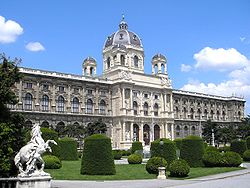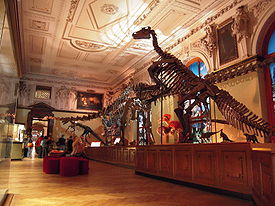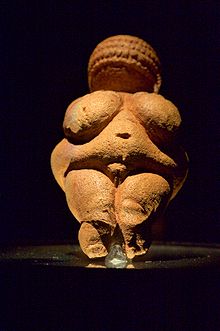- Naturhistorisches Museum
-
Museum of Natural History Naturhistorisches Museum 
Naturhistorisches MuseumEstablished 1872-1889 Location Vienna, Austria Director Christian Koeberl Website nhm-wien.ac.at The Naturhistorisches Museum Wien (en: Museum of Natural History of Vienna) or NHMW is a large museum located in Vienna, Austria.[1][2] The collections displayed cover 8,700 square metres (94,000 sq ft), and the museum has a website providing an overview as a video virtual tour.[2]
The Museum of Natural History in Vienna is one of the important museums of the world, and the earliest collections of artifacts were begun over 250 years ago.[1]
As of 2006, 20 million objects are scientifically maintained.[1]
Contents
The main building of the Museum is an elaborate palace that has accommodated these constantly growing collections, since opening to the public in 1889 as the Imperial Natural History Museum.[1] However, some of the collections had been moved from even older buildings, such as the Hofbibliothek which contained the Zoology Cabinet (German: Tierkabinett) collections.[3]
The interaction of the building, the ornate decoration, the furniture, and precious exhibits makes the museum also a "museum of the museum" for the cultural-historical preservation.[1]
Famous and irreplaceable exhibits, for instance the 25,000-year-old Venus of Willendorf, and a skeleton of a Diplodocus dinosaur, plus extinct animal or plant specimens from 200 million years ago such as the Steller sea-cow, are displayed along 39 halls.[1] Contemporary presentation by means of modern exhibition technology has been possible without destruction of the historical structures in the building.[1]
Floors
On the upper floor (Hochparterre) precious stones and minerals can be seen, along with large dinosaur displays and rare fossils, along with prehistoric art works: the Venus von Willendorf, the skeleton of Diplodocus, a giant topaz weighing 117 kg (258 lb), and the collection of jewels which Maria Theresia had made as a present for her husband.[2]
The first floor displays the species variety of the animal world, from protozoa to insects to highly developed mammals. Objects over 200 years old are of interest, not only on their own account but also as historical records for the history of science and the art of taxidermy: numerous stuffed animals of species either extinct, or extremely endangered, have made the collections irreplaceable.[2]
Note that most signs and explanations in the museum are in German only.
History
The museum building opened in 1889 at the same time as the Kunsthistorisches Museum. The two museums have identical exteriors and face each other across Maria-Theresien-Platz. The Museum was built to house the huge collection of the Habsburgs.
Both buildings were built between 1872 and 1891 on the Ringstraße according to plans drawn up by Gottfried Semper and Karl Freiherr von Hasenauer.
The insect collections date from 1793 when Franz I of Austria purchased the scientific collections of Joseph Natterer, Sr. (father of 6-year-old, and later zoologist, Johann Natterer). In 1806 the museum purchased a collection of European insects made by Johann Carl Megerle von Mühlfeld, and Megerle became the first curator of insects.[3] He organised the purchase of the Gundian collection of European butterflies. These old collections with Megerle's specimens were destroyed in October 1848, during a Hofburg fire;[3] however, Johann Natterer's journey to Brazil (1817-1835) had led to an enormous enhancement of the collections: 60,000 insects were a part of the "Brazilian museum" in the "Harrach' house" and escaped the fire.
In 1859, the frigate SMS Novara returned from a world voyage with Georg Ritter von Frauenfeld and Johann Zelebor,[3] and the insects were incorporated in the Vienna collections. These were worked on by Ludwig Redtenbacher (Coleoptera), Friedrich Moritz Brauer (Neuroptera and Diptera), Henri Louis Frederic de Saussure (Hymenoptera excluding Formicidae), Gustav Mayr (Formicidae and Hemiptera), Ignaz Rudolph Schiner (Diptera), C Felder, R. Felder and Alois Friedrich Rogenhofer (Lepidoptera).[3]
The present museum organization dates from 1876. The entomologists Ganglbauer and Karl Holdhaus (Coleoptera), Rogenhofer and Hans Rebel, Josef Emanuel Fischer von Röslerstamm, Josef Johann Mann (Lepidoptera), Franz Friedrich Kohl, Carl Tschek and Maidl (Hymenoptera), Brauer (Diptera and Neuroptera), and Anton Handlirsch (for fossil insects) contributed substantially to the international reputation of the museum.[3]
Photos
See also
- Kunsthistorisches Museum - the Fine Art Museum of Vienna, opposite.
- Technisches Museum Wien - technology museum in Vienna.
- Lobkowitz Palace - the theatrical museum of the Austrian National Library.
- Imperial Natural History Museum.
Notes
- ^ a b c d e f g "Museum of Natural History in Vienna" (overview), Naturhistorisches Museum Wien, 2006, webpage: NHM-Wien-overview.
- ^ a b c d "Museum of Natural History in Vienna" (English overview), Naturhistorisches Museum Wien, 2006, webpage: NHM-Wien-preview-English.
- ^ a b c d e f "History (Hauptframe)" (overview), Naturhistorisches Museum, Vienna, Austria, 2004, webpage:NHMW-history.
External links
- Official website (english)
- Annals Very useful early history of the museum.
- Flickr Photos of the museum. Exterior and interior.
Coordinates: 48°12′18″N 16°21′34″E / 48.205134°N 16.359394°E
Categories:- Innere Stadt
- Buildings and structures completed in 1891
- Museums in Vienna
- Natural history museums
- Museums of Dacia
Wikimedia Foundation. 2010.






